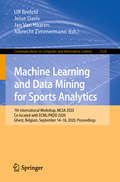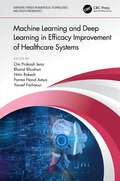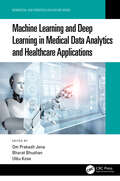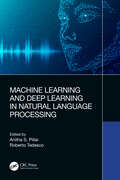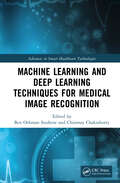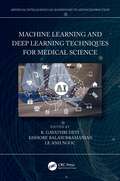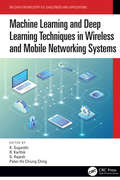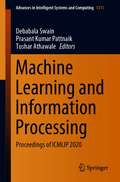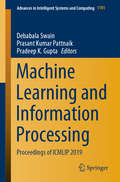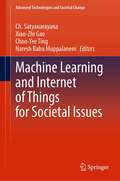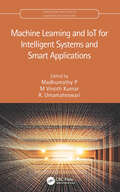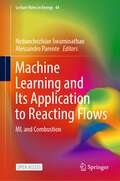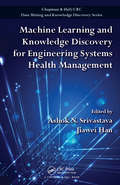- Table View
- List View
Machine Learning and Data Mining for Sports Analytics: 7th International Workshop, MLSA 2020, Co-located with ECML/PKDD 2020, Ghent, Belgium, September 14–18, 2020, Proceedings (Communications in Computer and Information Science #1324)
by Ulf Brefeld Jesse Davis Jan Van Haaren Albrecht ZimmermannThis book constitutes the refereed post-conference proceedings of the 7th International Workshop on Machine Learning and Data Mining for Sports Analytics, MLSA 2020, colocated with ECML/PKDD 2020, in Ghent, Belgium, in September 2020. Due to the COVID-19 pandemic the conference was held online. The 11 papers presented were carefully reviewed and selected from 22 submissions. The papers present a variety of topics within the area of sports analytics, including tactical analysis, outcome predictions, data acquisition, performance optimization, and player evaluation.
Machine Learning and Data Mining in Aerospace Technology (Studies in Computational Intelligence #836)
by Aboul Ella Hassanien Ashraf Darwish Hesham El-AskaryThis book explores the main concepts, algorithms, and techniques of Machine Learning and data mining for aerospace technology. Satellites are the ‘eagle eyes’ that allow us to view massive areas of the Earth simultaneously, and can gather more data, more quickly, than tools on the ground. Consequently, the development of intelligent health monitoring systems for artificial satellites – which can determine satellites’ current status and predict their failure based on telemetry data – is one of the most important current issues in aerospace engineering.This book is divided into three parts, the first of which discusses central problems in the health monitoring of artificial satellites, including tensor-based anomaly detection for satellite telemetry data and machine learning in satellite monitoring, as well as the design, implementation, and validation of satellite simulators. The second part addresses telemetry data analytics and mining problems, while the last part focuses on security issues in telemetry data.
Machine Learning and Deep Learning in Efficacy Improvement of Healthcare Systems (Emerging Trends in Biomedical Technologies and Health informatics)
by Om Prakash JenaThe goal of medical informatics is to improve life expectancy, disease diagnosis and quality of life. Medical devices have revolutionized healthcare and have led to the modern age of machine learning, deep learning and Internet of Medical Things (IoMT) with their proliferation, mobility and agility. This book exposes different dimensions of applications for computational intelligence and explains its use in solving various biomedical and healthcare problems in the real world. This book describes the fundamental concepts of machine learning and deep learning techniques in a healthcare system. The aim of this book is to describe how deep learning methods are used to ensure high-quality data processing, medical image and signal analysis and improved healthcare applications. This book also explores different dimensions of computational intelligence applications and illustrates its use in the solution of assorted real-world biomedical and healthcare problems. Furthermore, it provides the healthcare sector with innovative advances in theory, analytical approaches, numerical simulation, statistical analysis, modelling, advanced deployment, case studies, analytical results, computational structuring and significant progress in the field of machine learning and deep learning in healthcare applications. FEATURES Explores different dimensions of computational intelligence applications and illustrates its use in the solution of assorted real-world biomedical and healthcare problems Provides guidance in developing intelligence-based diagnostic systems, efficient models and cost-effective machines Provides the latest research findings, solutions to the concerning issues and relevant theoretical frameworks in the area of machine learning and deep learning for healthcare systems Describes experiences and findings relating to protocol design, prototyping, experimental evaluation, real testbeds and empirical characterization of security and privacy interoperability issues in healthcare applications Explores and illustrates the current and future impacts of pandemics and mitigates risk in healthcare with advanced analytics This book is intended for students, researchers, professionals and policy makers working in the fields of public health and in the healthcare sector. Scientists and IT specialists will also find this book beneficial for research exposure and new ideas in the field of machine learning and deep learning.
Machine Learning and Deep Learning in Efficacy Improvement of Healthcare Systems (Emerging Trends in Biomedical Technologies and Health informatics)
by Om Prakash Jena Bharat Bhushan Nitin Rakesh Parma Nand Astya Yousef FarhaouiThe goal of medical informatics is to improve life expectancy, disease diagnosis and quality of life. Medical devices have revolutionized healthcare and have led to the modern age of machine learning, deep learning and Internet of Medical Things (IoMT) with their proliferation, mobility and agility. This book exposes different dimensions of applications for computational intelligence and explains its use in solving various biomedical and healthcare problems in the real world. This book describes the fundamental concepts of machine learning and deep learning techniques in a healthcare system. The aim of this book is to describe how deep learning methods are used to ensure high-quality data processing, medical image and signal analysis and improved healthcare applications. This book also explores different dimensions of computational intelligence applications and illustrates its use in the solution of assorted real-world biomedical and healthcare problems. Furthermore, it provides the healthcare sector with innovative advances in theory, analytical approaches, numerical simulation, statistical analysis, modelling, advanced deployment, case studies, analytical results, computational structuring and significant progress in the field of machine learning and deep learning in healthcare applications. FEATURES Explores different dimensions of computational intelligence applications and illustrates its use in the solution of assorted real-world biomedical and healthcare problems Provides guidance in developing intelligence-based diagnostic systems, efficient models and cost-effective machines Provides the latest research findings, solutions to the concerning issues and relevant theoretical frameworks in the area of machine learning and deep learning for healthcare systems Describes experiences and findings relating to protocol design, prototyping, experimental evaluation, real testbeds and empirical characterization of security and privacy interoperability issues in healthcare applications Explores and illustrates the current and future impacts of pandemics and mitigates risk in healthcare with advanced analytics This book is intended for students, researchers, professionals and policy makers working in the fields of public health and in the healthcare sector. Scientists and IT specialists will also find this book beneficial for research exposure and new ideas in the field of machine learning and deep learning.
Machine Learning and Deep Learning in Medical Data Analytics and Healthcare Applications (Biomedical and Robotics Healthcare)
by Om Prakash JenaMachine Learning and Deep Learning in Medical Data Analytics and Healthcare Applications introduces and explores a variety of schemes designed to empower, enhance, and represent multi-institutional and multi-disciplinary machine learning (ML) and deep learning (DL) research in healthcare paradigms. Serving as a unique compendium of existing and emerging ML/DL paradigms for the healthcare sector, this book demonstrates the depth, breadth, complexity, and diversity of this multi-disciplinary area. It provides a comprehensive overview of ML/DL algorithms and explores the related use cases in enterprises such as computer-aided medical diagnostics, drug discovery and development, medical imaging, automation, robotic surgery, electronic smart records creation, outbreak prediction, medical image analysis, and radiation treatments. This book aims to endow different communities with the innovative advances in theory, analytical results, case studies, numerical simulation, modeling, and computational structuring in the field of ML/DL models for healthcare applications. It will reveal different dimensions of ML/DL applications and will illustrate their use in the solution of assorted real-world biomedical and healthcare problems. Features: Covers the fundamentals of ML and DL in the context of healthcare applications Discusses various data collection approaches from various sources and how to use them in ML/DL models Integrates several aspects of AI-based computational intelligence such as ML and DL from diversified perspectives which describe recent research trends and advanced topics in the field Explores the current and future impacts of pandemics and risk mitigation in healthcare with advanced analytics Emphasizes feature selection as an important step in any accurate model simulation where ML/DL methods are used to help train the system and extract the positive solution implicitly This book is a valuable source of information for researchers, scientists, healthcare professionals, programmers, and graduate-level students interested in understanding the applications of ML/DL in healthcare scenarios. Dr. Om Prakash Jena is an Assistant Professor in the Department of Computer Science, Ravenshaw University, Cuttack, Odisha, India. Dr. Bharat Bhushan is an Assistant Professor of Department of Computer Science and Engineering (CSE) at the School of Engineering and Technology, Sharda University, Greater Noida, India. Dr. Utku Kose is an Associate Professor in Suleyman Demirel University, Turkey.
Machine Learning and Deep Learning in Medical Data Analytics and Healthcare Applications (Biomedical and Robotics Healthcare)
by Om Prakash Jena Bharat Bhushan Utku KoseMachine Learning and Deep Learning in Medical Data Analytics and Healthcare Applications introduces and explores a variety of schemes designed to empower, enhance, and represent multi-institutional and multi-disciplinary machine learning (ML) and deep learning (DL) research in healthcare paradigms. Serving as a unique compendium of existing and emerging ML/DL paradigms for the healthcare sector, this book demonstrates the depth, breadth, complexity, and diversity of this multi-disciplinary area. It provides a comprehensive overview of ML/DL algorithms and explores the related use cases in enterprises such as computer-aided medical diagnostics, drug discovery and development, medical imaging, automation, robotic surgery, electronic smart records creation, outbreak prediction, medical image analysis, and radiation treatments. This book aims to endow different communities with the innovative advances in theory, analytical results, case studies, numerical simulation, modeling, and computational structuring in the field of ML/DL models for healthcare applications. It will reveal different dimensions of ML/DL applications and will illustrate their use in the solution of assorted real-world biomedical and healthcare problems. Features: Covers the fundamentals of ML and DL in the context of healthcare applications Discusses various data collection approaches from various sources and how to use them in ML/DL models Integrates several aspects of AI-based computational intelligence such as ML and DL from diversified perspectives which describe recent research trends and advanced topics in the field Explores the current and future impacts of pandemics and risk mitigation in healthcare with advanced analytics Emphasizes feature selection as an important step in any accurate model simulation where ML/DL methods are used to help train the system and extract the positive solution implicitly This book is a valuable source of information for researchers, scientists, healthcare professionals, programmers, and graduate-level students interested in understanding the applications of ML/DL in healthcare scenarios. Dr. Om Prakash Jena is an Assistant Professor in the Department of Computer Science, Ravenshaw University, Cuttack, Odisha, India. Dr. Bharat Bhushan is an Assistant Professor of Department of Computer Science and Engineering (CSE) at the School of Engineering and Technology, Sharda University, Greater Noida, India. Dr. Utku Kose is an Associate Professor in Suleyman Demirel University, Turkey.
Machine Learning and Deep Learning in Natural Language Processing
by Anitha S. Pillai Roberto TedescoNatural Language Processing (NLP) is a sub-field of Artificial Intelligence, linguistics, and computer science and is concerned with the generation, recognition, and understanding of human languages, both written and spoken. NLP systems examine the grammatical structure of sentences as well as the specific meanings of words, and then they utilize algorithms to extract meaning and produce results. Machine Learning and Deep Learning in Natural Language Processing aims at providing a review of current Neural Network techniques in the NLP field, in particular about Conversational Agents (chatbots), Text-to-Speech, management of non-literal content – like emotions, but also satirical expressions – and applications in the healthcare field. NLP has the potential to be a disruptive technology in various healthcare fields, but so far little attention has been devoted to that goal. This book aims at providing some examples of NLP techniques that can, for example, restore speech, detect Parkinson’s disease, or help psychotherapists. This book is intended for a wide audience. Beginners will find useful chapters providing a general introduction to NLP techniques, while experienced professionals will appreciate the chapters about advanced management of emotion, empathy, and non-literal content.
Machine Learning and Deep Learning in Natural Language Processing
by Anitha S. Pillai Roberto TedescoNatural Language Processing (NLP) is a sub-field of Artificial Intelligence, linguistics, and computer science and is concerned with the generation, recognition, and understanding of human languages, both written and spoken. NLP systems examine the grammatical structure of sentences as well as the specific meanings of words, and then they utilize algorithms to extract meaning and produce results. Machine Learning and Deep Learning in Natural Language Processing aims at providing a review of current Neural Network techniques in the NLP field, in particular about Conversational Agents (chatbots), Text-to-Speech, management of non-literal content – like emotions, but also satirical expressions – and applications in the healthcare field. NLP has the potential to be a disruptive technology in various healthcare fields, but so far little attention has been devoted to that goal. This book aims at providing some examples of NLP techniques that can, for example, restore speech, detect Parkinson’s disease, or help psychotherapists. This book is intended for a wide audience. Beginners will find useful chapters providing a general introduction to NLP techniques, while experienced professionals will appreciate the chapters about advanced management of emotion, empathy, and non-literal content.
Machine Learning and Deep Learning Techniques for Medical Image Recognition (Advances in Smart Healthcare Technologies)
by Ben Othman Soufiene and Chinmay ChakrabortyMachine Learning and Deep Learning Techniques for Medical Image Recognition comprehensively reviews deep learning-based algorithms in medical image analysis problems including medical image processing. It includes a detailed review of deep learning approaches for semantic object detection and segmentation in medical image computing and large-scale radiology database mining. A particular focus is placed on the application of convolutional neural networks with the theory and varied selection of techniques for semantic segmentation using deep learning principles in medical imaging supported by practical examples. Features: Offers important key aspects in the development and implementation of machine learning and deep learning approaches toward developing prediction tools and models and improving medical diagnosis Teaches how machine learning and deep learning algorithms are applied to a broad range of application areas, including chest X-ray, breast computer-aided detection, lung and chest, microscopy, and pathology Covers common research problems in medical image analysis and their challenges Focuses on aspects of deep learning and machine learning for combating COVID-19 Includes pertinent case studies This book is aimed at researchers and graduate students in computer engineering, artificial intelligence and machine learning, and biomedical imaging.
Machine Learning and Deep Learning Techniques for Medical Image Recognition (Advances in Smart Healthcare Technologies)
by Ben Othman Soufiene Chinmay ChakrabortyMachine Learning and Deep Learning Techniques for Medical Image Recognition comprehensively reviews deep learning-based algorithms in medical image analysis problems including medical image processing. It includes a detailed review of deep learning approaches for semantic object detection and segmentation in medical image computing and large-scale radiology database mining. A particular focus is placed on the application of convolutional neural networks with the theory and varied selection of techniques for semantic segmentation using deep learning principles in medical imaging supported by practical examples. Features: Offers important key aspects in the development and implementation of machine learning and deep learning approaches toward developing prediction tools and models and improving medical diagnosis Teaches how machine learning and deep learning algorithms are applied to a broad range of application areas, including chest X-ray, breast computer-aided detection, lung and chest, microscopy, and pathology Covers common research problems in medical image analysis and their challenges Focuses on aspects of deep learning and machine learning for combating COVID-19 Includes pertinent case studies This book is aimed at researchers and graduate students in computer engineering, artificial intelligence and machine learning, and biomedical imaging.
Machine Learning and Deep Learning Techniques for Medical Science (Artificial Intelligence (AI): Elementary to Advanced Practices)
by K. Gayathri DeviThe application of machine learning is growing exponentially into every branch of business and science, including medical science. This book presents the integration of machine learning (ML) and deep learning (DL) algorithms that can be applied in the healthcare sector to reduce the time required by doctors, radiologists, and other medical professionals for analyzing, predicting, and diagnosing the conditions with accurate results. The book offers important key aspects in the development and implementation of ML and DL approaches toward developing prediction tools and models and improving medical diagnosis. The contributors explore the recent trends, innovations, challenges, and solutions, as well as case studies of the applications of ML and DL in intelligent system-based disease diagnosis. The chapters also highlight the basics and the need for applying mathematical aspects with reference to the development of new medical models. Authors also explore ML and DL in relation to artificial intelligence (AI) prediction tools, the discovery of drugs, neuroscience, diagnosis in multiple imaging modalities, and pattern recognition approaches to functional magnetic resonance imaging images. This book is for students and researchers of computer science and engineering, electronics and communication engineering, and information technology; for biomedical engineering researchers, academicians, and educators; and for students and professionals in other areas of the healthcare sector. Presents key aspects in the development and the implementation of ML and DL approaches toward developing prediction tools, models, and improving medical diagnosis Discusses the recent trends, innovations, challenges, solutions, and applications of intelligent system-based disease diagnosis Examines DL theories, models, and tools to enhance health information systems Explores ML and DL in relation to AI prediction tools, discovery of drugs, neuroscience, and diagnosis in multiple imaging modalities Dr. K. Gayathri Devi is a Professor at the Department of Electronics and Communication Engineering, Dr. N.G.P Institute of Technology, Tamil Nadu, India. Dr. Kishore Balasubramanian is an Assistant Professor (Senior Scale) at the Department of EEE at Dr. Mahalingam College of Engineering & Technology, Tamil Nadu, India. Dr. Le Anh Ngoc is a Director of Swinburne Innovation Space and Professor in Swinburne University of Technology (Vietnam).
Machine Learning and Deep Learning Techniques for Medical Science (Artificial Intelligence (AI): Elementary to Advanced Practices)
by K. Gayathri Devi Kishore Balasubramanian Le Anh NgocThe application of machine learning is growing exponentially into every branch of business and science, including medical science. This book presents the integration of machine learning (ML) and deep learning (DL) algorithms that can be applied in the healthcare sector to reduce the time required by doctors, radiologists, and other medical professionals for analyzing, predicting, and diagnosing the conditions with accurate results. The book offers important key aspects in the development and implementation of ML and DL approaches toward developing prediction tools and models and improving medical diagnosis. The contributors explore the recent trends, innovations, challenges, and solutions, as well as case studies of the applications of ML and DL in intelligent system-based disease diagnosis. The chapters also highlight the basics and the need for applying mathematical aspects with reference to the development of new medical models. Authors also explore ML and DL in relation to artificial intelligence (AI) prediction tools, the discovery of drugs, neuroscience, diagnosis in multiple imaging modalities, and pattern recognition approaches to functional magnetic resonance imaging images. This book is for students and researchers of computer science and engineering, electronics and communication engineering, and information technology; for biomedical engineering researchers, academicians, and educators; and for students and professionals in other areas of the healthcare sector. Presents key aspects in the development and the implementation of ML and DL approaches toward developing prediction tools, models, and improving medical diagnosis Discusses the recent trends, innovations, challenges, solutions, and applications of intelligent system-based disease diagnosis Examines DL theories, models, and tools to enhance health information systems Explores ML and DL in relation to AI prediction tools, discovery of drugs, neuroscience, and diagnosis in multiple imaging modalities Dr. K. Gayathri Devi is a Professor at the Department of Electronics and Communication Engineering, Dr. N.G.P Institute of Technology, Tamil Nadu, India. Dr. Kishore Balasubramanian is an Assistant Professor (Senior Scale) at the Department of EEE at Dr. Mahalingam College of Engineering & Technology, Tamil Nadu, India. Dr. Le Anh Ngoc is a Director of Swinburne Innovation Space and Professor in Swinburne University of Technology (Vietnam).
Machine Learning and Deep Learning Techniques in Wireless and Mobile Networking Systems (Big Data for Industry 4.0)
by K. Suganthi R. Karthik G. Rajesh Peter Ho Chiung ChingThis book offers the latest advances and results in the fields of Machine Learning and Deep Learning for Wireless Communication and provides positive and critical discussions on the challenges and prospects. It provides a broad spectrum in understanding the improvements in Machine Learning and Deep Learning that are motivating by the specific constraints posed by wireless networking systems. The book offers an extensive overview on intelligent Wireless Communication systems and its underlying technologies, research challenges, solutions, and case studies. It provides information on intelligent wireless communication systems and its models, algorithms and applications. The book is written as a reference that offers the latest technologies and research results to various industry problems.
Machine Learning and Deep Learning Techniques in Wireless and Mobile Networking Systems (Big Data for Industry 4.0)
by K. Suganthi R. Karthik G. Rajesh Peter Ho Chiung ChingThis book offers the latest advances and results in the fields of Machine Learning and Deep Learning for Wireless Communication and provides positive and critical discussions on the challenges and prospects. It provides a broad spectrum in understanding the improvements in Machine Learning and Deep Learning that are motivating by the specific constraints posed by wireless networking systems. The book offers an extensive overview on intelligent Wireless Communication systems and its underlying technologies, research challenges, solutions, and case studies. It provides information on intelligent wireless communication systems and its models, algorithms and applications. The book is written as a reference that offers the latest technologies and research results to various industry problems.
Machine Learning and Flow Assurance in Oil and Gas Production
by Bhajan Lal Cornelius Borecho Bavoh Jai Krishna Sahith SayaniThis book is useful to flow assurance engineers, students, and industries who wish to be flow assurance authorities in the twenty-first-century oil and gas industry.The use of digital or artificial intelligence methods in flow assurance has increased recently to achieve fast results without any thorough training effectively. Generally, flow assurance covers all risks associated with maintaining the flow of oil and gas during any stage in the petroleum industry. Flow assurance in the oil and gas industry covers the anticipation, limitation, and/or prevention of hydrates, wax, asphaltenes, scale, and corrosion during operation. Flow assurance challenges mostly lead to stoppage of production or plugs, damage to pipelines or production facilities, economic losses, and in severe cases blowouts and loss of human lives. A combination of several chemical and non-chemical techniques is mostly used to prevent flow assurance issues in the industry. However, the use of models to anticipate, limit, and/or prevent flow assurance problems is recommended as the best and most suitable practice. The existing proposed flow assurance models on hydrates, wax, asphaltenes, scale, and corrosion management are challenged with accuracy and precision. They are not also limited by several parametric assumptions. Recently, machine learning methods have gained much attention as best practices for predicting flow assurance issues. Examples of these machine learning models include conventional approaches such as artificial neural network, support vector machine (SVM), least square support vector machine (LSSVM), random forest (RF), and hybrid models. The use of machine learning in flow assurance is growing, and thus, relevant knowledge and guidelines on their application methods and effectiveness are needed for academic, industrial, and research purposes.In this book, the authors focus on the use and abilities of various machine learning methods in flow assurance. Initially, basic definitions and use of machine learning in flow assurance are discussed in a broader scope within the oil and gas industry. The rest of the chapters discuss the use of machine learning in various flow assurance areas such as hydrates, wax, asphaltenes, scale, and corrosion. Also, the use of machine learning in practical field applications is discussed to understand the practical use of machine learning in flow assurance.
Machine Learning and Granular Computing: A Synergistic Design Environment (Studies in Big Data #155)
by Witold Pedrycz Shyi-Ming ChenThis volume provides the reader with a comprehensive and up-to-date treatise positioned at the junction of the areas of Machine Learning (ML) and Granular Computing (GrC). ML offers a wealth of architectures and learning methods. Granular Computing addresses useful aspects of abstraction and knowledge representation that are of importance in the advanced design of ML architectures. In unison, ML and GrC support advances of the fundamental learning paradigm. As built upon synergy, this unified environment focuses on a spectrum of methodological and algorithmic issues, discusses implementations and elaborates on applications. The chapters bring forward recent developments showing ways of designing synergistic and coherently structured ML-GrC environment. The book will be of interest to a broad audience including researchers and practitioners active in the area of ML or GrC and interested in following its timely trends and new pursuits.
Machine Learning and Image Interpretation (Advances in Computer Vision and Machine Intelligence)
by Terry Caelli Walter F. BischofIn this groundbreaking new volume, computer researchers discuss the development of technologies and specific systems that can interpret data with respect to domain knowledge. Although the chapters each illuminate different aspects of image interpretation, all utilize a common approach - one that asserts such interpretation must involve perceptual learning in terms of automated knowledge acquisition and application, as well as feedback and consistency checks between encoding, feature extraction, and the known knowledge structures in a given application domain. The text is profusely illustrated with numerous figures and tables to reinforce the concepts discussed.
Machine Learning and Information Processing: Proceedings of ICMLIP 2020 (Advances in Intelligent Systems and Computing #1311)
by Debabala Swain Prasant Kumar Pattnaik Tushar AthawaleThis book includes selected papers from the 2nd International Conference on Machine Learning and Information Processing (ICMLIP 2020), held at Vardhaman College of Engineering, Jawaharlal Nehru Technological University (JNTU), Hyderabad, India, from November 28 to 29, 2020. It presents the latest developments and technical solutions in the areas of advanced computing and data sciences, covering machine learning, artificial intelligence, human–computer interaction, IoT, deep learning, image processing and pattern recognition, and signal and speech processing.
Machine Learning and Information Processing: Proceedings of ICMLIP 2019 (Advances in Intelligent Systems and Computing #1101)
by Debabala Swain Prasant Kumar Pattnaik Pradeep K. GuptaThis book includes selected papers from the International Conference on Machine Learning and Information Processing (ICMLIP 2019), held at ISB&M School of Technology, Pune, Maharashtra, India, from December 27 to 28, 2019. It presents the latest developments and technical solutions in the areas of advanced computing and data sciences, covering machine learning, artificial intelligence, human–computer interaction, IoT, deep learning, image processing and pattern recognition, and signal and speech processing.
Machine Learning and Internet of Things for Societal Issues (Advanced Technologies and Societal Change)
by Xiao-Zhi Gao Naresh Babu Muppalaneni Ch. Satyanarayana Choo-Yee TingThis book highlights recent advance in the area of Machine Learning and IoT, and their applications to solve societal issues/problems or useful for various users in the society. It is known that many smart devices are interconnected and the data generated is being analyzed and processed with machine learning models for prediction, classification, etc., to solve human needs in various sectors like health, road safety, agriculture, and education. This contributed book puts together chapters concerning the use of intelligent techniques in various aspects related to the IoT domain from protocols to applications, to give the reader an up-to-date picture of the state-of-the-art on the connection between computational intelligence, machine learning, and IoT.
Machine Learning and IoT for Intelligent Systems and Smart Applications (Computational Intelligence in Engineering Problem Solving)
by Madhumathy P.The fusion of AI and IoT enables the systems to be predictive, prescriptive, and autonomous, and this convergence has evolved the nature of emerging applications from being assisted to augmented, and ultimately to autonomous intelligence. This book discusses algorithmic applications in the field of machine learning and IoT with pertinent applications. It further discusses challenges and future directions in the machine learning area and develops understanding of its role in technology, in terms of IoT security issues. Pertinent applications described include speech recognition, medical diagnosis, optimizations, predictions, and security aspects. Features: Focuses on algorithmic and practical parts of the artificial intelligence approaches in IoT applications. Discusses supervised and unsupervised machine learning for IoT data and devices. Presents an overview of the different algorithms related to Machine learning and IoT. Covers practical case studies on industrial and smart home automation. Includes implementation of AI from case studies in personal and industrial IoT. This book aims at Researchers and Graduate students in Computer Engineering, Networking Communications, Information Science Engineering, and Electrical Engineering.
Machine Learning and IoT for Intelligent Systems and Smart Applications (Computational Intelligence in Engineering Problem Solving)
by Madhumathy P M. Vinoth Kumar R. UmamaheswariThe fusion of AI and IoT enables the systems to be predictive, prescriptive, and autonomous, and this convergence has evolved the nature of emerging applications from being assisted to augmented, and ultimately to autonomous intelligence. This book discusses algorithmic applications in the field of machine learning and IoT with pertinent applications. It further discusses challenges and future directions in the machine learning area and develops understanding of its role in technology, in terms of IoT security issues. Pertinent applications described include speech recognition, medical diagnosis, optimizations, predictions, and security aspects. Features: Focuses on algorithmic and practical parts of the artificial intelligence approaches in IoT applications. Discusses supervised and unsupervised machine learning for IoT data and devices. Presents an overview of the different algorithms related to Machine learning and IoT. Covers practical case studies on industrial and smart home automation. Includes implementation of AI from case studies in personal and industrial IoT. This book aims at Researchers and Graduate students in Computer Engineering, Networking Communications, Information Science Engineering, and Electrical Engineering.
Machine Learning and Its Application to Reacting Flows: ML and Combustion (Lecture Notes in Energy #44)
by Nedunchezhian Swaminathan Alessandro ParenteThis open access book introduces and explains machine learning (ML) algorithms and techniques developed for statistical inferences on a complex process or system and their applications to simulations of chemically reacting turbulent flows.These two fields, ML and turbulent combustion, have large body of work and knowledge on their own, and this book brings them together and explain the complexities and challenges involved in applying ML techniques to simulate and study reacting flows. This is important as to the world’s total primary energy supply (TPES), since more than 90% of this supply is through combustion technologies and the non-negligible effects of combustion on environment. Although alternative technologies based on renewable energies are coming up, their shares for the TPES is are less than 5% currently and one needs a complete paradigm shift to replace combustion sources. Whether this is practical or not is entirely a different question, and an answer to this question depends on the respondent. However, a pragmatic analysis suggests that the combustion share to TPES is likely to be more than 70% even by 2070. Hence, it will be prudent to take advantage of ML techniques to improve combustion sciences and technologies so that efficient and “greener” combustion systems that are friendlier to the environment can be designed. The book covers the current state of the art in these two topics and outlines the challenges involved, merits and drawbacks of using ML for turbulent combustion simulations including avenues which can be explored to overcome the challenges. The required mathematical equations and backgrounds are discussed with ample references for readers to find further detail if they wish. This book is unique since there is not any book with similar coverage of topics, ranging from big data analysis and machine learning algorithm to their applications for combustion science and system design for energy generation.
Machine Learning and Knowledge Discovery for Engineering Systems Health Management
by Ashok N. Srivastava Jiawei HanThis volume presents state-of-the-art tools and techniques for automatically detecting, diagnosing, and predicting the effects of adverse events in an engineered system. It emphasizes the importance of these techniques in managing the intricate interactions within and between engineering systems to maintain a high degree of reliability. Reflecting the interdisciplinary nature of the field, the book explains how the fundamental algorithms and methods of both physics-based and data-driven approaches effectively address systems health management in application areas such as data centers, aircraft, and software systems.
Machine Learning and Knowledge Discovery for Engineering Systems Health Management
by Ashok N. Srivastava Jiawei HanThis volume presents state-of-the-art tools and techniques for automatically detecting, diagnosing, and predicting the effects of adverse events in an engineered system. It emphasizes the importance of these techniques in managing the intricate interactions within and between engineering systems to maintain a high degree of reliability. Reflecting the interdisciplinary nature of the field, the book explains how the fundamental algorithms and methods of both physics-based and data-driven approaches effectively address systems health management in application areas such as data centers, aircraft, and software systems.
